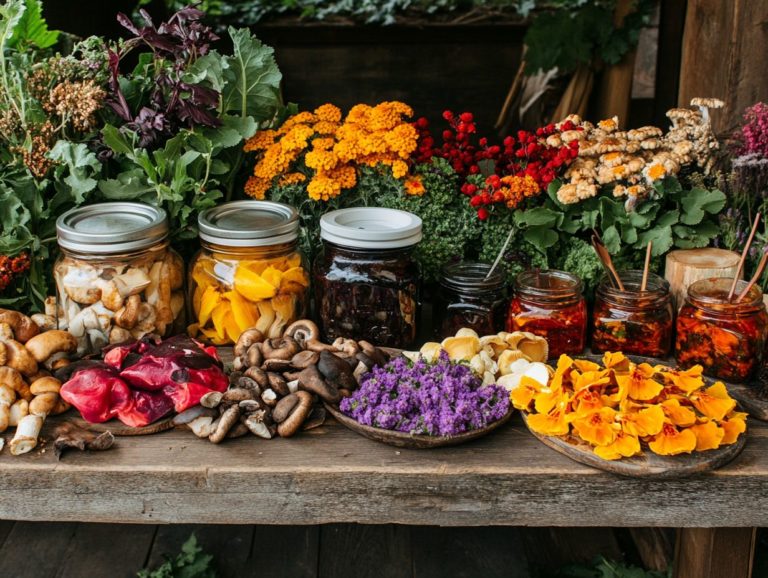Foraging for Nuts: Seasonal Tips and Tricks
Foraging has made quite the comeback, attracting outdoor lovers and food explorers.
This article delves into the exciting world of nut gathering, offering you insights into the various types of nuts available throughout the seasons, the basic tools you need for foraging trips, and best practices to ensure a safe and rewarding experience in seasonal foraging.
You ll gain the knowledge to identify edible plants, differentiate them from their harmful counterparts, and explore effective techniques for cleaning and preserving your prized finds.
Join the adventure of foraging! Explore the world of roots, fruits, and flowers that enhance your foraging experience.
Contents
- Key Takeaways:
- Types of Nuts to Look for
- Tools and Equipment for Foraging
- Best Practices for Foraging
- Identifying Edible Nuts
- Preparing and Storing Foraged Nuts
- Frequently Asked Questions
- What are the best nuts to forage for during the fall season?
- How do I know when nuts are ready to be foraged?
- What equipment do I need for foraging nuts?
- Are there any safety precautions I should take while foraging for nuts?
- What are some tips for properly storing foraged nuts?
- Can I forage for nuts in urban areas?
Key Takeaways:

- Enjoy the seasonal bounty of nuts by foraging with the right tools and knowledge, including plant identification skills, which means knowing how to recognize safe plants.
- Take safety considerations seriously. Practice proper etiquette while foraging to protect yourself and the environment.
- Properly identify, clean, and preserve nuts to ensure their safety and deliciousness in your recipes by employing proper harvesting techniques.
What is Foraging and Why is it Popular?
Foraging, the art of seeking out and gathering wild edible plants, has captured the attention of nature enthusiasts and culinary explorers alike. Foraging helps you connect with wild landscapes while uncovering a treasure trove of seasonal edible plants. Foraging provides a sustainable food source and offers a myriad of medicinal benefits through local flora like Pine Needle, Dandelion Root, and Chickweed, enriching your appreciation for the environment.
Historically, foraging was essential for human survival, serving as the primary method of food acquisition long before agriculture took the spotlight. Recently, a renewed interest in this ancient practice has surged, spurred by trends in herbalism, sustainability, and a collective yearning to reconnect with the natural world.
As you embrace ecological awareness, foraging becomes more than just a means to gather food. It fosters environmental stewardship by deepening your understanding of local ecosystems and their biodiversity. This harmonious relationship cultivates respect for nature. You learn the importance of each plant while supporting the preservation of natural habitats. In this way, foraging embodies a lifestyle rooted in sustainability and reverence for the Earth’s resources.
Types of Nuts to Look for
When you set out on a foraging adventure, it’s crucial to familiarize yourself with the various types of nuts available in your local area. These nutrient-dense treasures not only offer culinary excitement but also enhance your understanding of harvesting wild grains and create a meaningful connection to the natural world and the seasonal rhythms of local plants.
Common Nuts Found in Different Seasons
Each season unveils its own unique array of nuts waiting for you to discover, from acorns in autumn to hazelnuts in late summer. For those interested in this practice, foraging in different seasons transforms your explorations into exciting adventures through the wild landscapes around you.
In spring, you’ll delight in the emergence of black walnuts, easily recognized by their rough, dark exterior. As mid-summer rolls in, the smooth, oval form of the pecan takes center stage. To become a savvy forager, pay attention to the distinct leaf patterns and growth habits of these nuts. Walnuts love to flourish near rivers and streams, while pecans prefer sandy, well-drained soils.
In your kitchen, these nuts can elevate a wide range of culinary creations, from savory dishes to indulgent desserts. If you’re new to foraging, remember to accurately identify each nut, as some varieties may require special preparation to eliminate toxins. For those looking to enhance their skills, exploring summer foraging essentials ensures your foraging adventure is both safe and enjoyable.
Tools and Equipment for Foraging
Equipping yourself with the right tools and equipment is essential for a successful foraging experience. These elements not only boost your efficiency in gathering edible plants and nuts but also play a significant role in ensuring the safe and sustainable harvesting of nature’s resources.
Don t miss out! Start your foraging journey today!
Essential Items for a Successful Foraging Trip

An enjoyable and fruitful foraging trip hinges on a few essential items: sturdy footwear, a reliable identification guide, and safety gear to tackle any potential environmental hazards you might encounter while exploring local parks and wild landscapes. These items enhance your foraging skills and ensure your safety.
Sturdy footwear offers protection against rough terrain, giving you the confidence to traverse various landscapes. The identification guide becomes your trusted companion, preventing any unfortunate encounters with toxic species.
Safety gear, including gloves, a first-aid kit, and insect repellent, helps mitigate risks associated with the great outdoors. Equipped with these tools, you can confidently navigate diverse ecosystems, embracing the joys of wild harvesting while remaining mindful of your surroundings and preserving the delicate balance of nature.
Best Practices for Foraging
By implementing best practices for foraging, you not only safeguard your well-being during foraging trips but also champion sustainable methods that protect natural habitats. This thoughtful approach supports environmental stewardship, creating a win-win situation for both the ecosystems and the foragers who depend on them.
Safety Tips and Etiquette
When you embark on a foraging adventure, adhering to safety tips and etiquette is essential. This approach ensures your respect for nature and helps you avoid hazardous plants while positively contributing to the ecosystems you explore.
Mastering plant identification is your ticket to a safe and rewarding foraging adventure! Mistaking edible varieties for their poisonous counterparts can pose serious health risks. Therefore, investing time in learning about the plants in your area through reputable guides or local workshops is well worth it.
It’s also vital to steer clear of polluted areas, as plants growing in contaminated soil or near industrial sites may absorb harmful toxins. On a social note, always seek permission before accessing private lands. This simple act honors the rights of landowners and fosters positive relationships within local communities, showcasing your commitment to responsible and respectful foraging practices.
Identifying Edible Nuts
Identifying edible nuts in the wild demands careful observation and a comprehensive grasp of plant identification. Distinguishing between safe varieties and those that may be poisonous is crucial; it can determine whether you enjoy a delightful meal or face a serious health risk.
How to Distinguish Between Safe and Poisonous Nuts
To safely forage for edible nuts, it’s essential for you to learn how to distinguish between the safe and the poisonous varieties. Mastering plant identification techniques and following seasonal foraging techniques will help ensure a secure and enjoyable experience.
Understanding the characteristics of different nuts is crucial. For instance, edible nuts typically have a recognizable shell and a delightful aroma, whereas their poisonous counterparts might present a bitter taste or peculiar markings.
Familiarizing yourself with the local plants is key, as many regions host specific species. Pay attention to leaf shape, tree bark, and the growth patterns of the nuts; these details can significantly aid in accurate identification.
Consider joining local foraging groups or workshops. They offer invaluable hands-on experience and expert guidance. This knowledge will not only keep you safe while foraging but also deepen your appreciation for nature’s abundant offerings.
Preparing and Storing Foraged Nuts

Once you’ve skillfully foraged your nuts, mastering the art of preparation and storage becomes paramount. By employing meticulous cleaning, shelling, and preservation techniques, you can elevate their flavor and significantly extend their shelf life. For more insights, check out seasonal foraging techniques for each season.
Get ready to explore your local parks and discover the natural treasures waiting for you!
Cleaning, Shelling, and Preserving Techniques
Cleaning, shelling, and preserving techniques are essential steps to ensure that your foraged nuts retain their flavor, nutritional value, and safety for consumption over time. For more detailed methods, check out this seasonal guide for foraging.
First, rinse your foraged nuts under cool water. This removes dirt and debris. After rinsing, allow them to air dry to prevent mold growth.
When shelling, keep in mind that methods can vary. For instance, hickory nuts typically require a sturdy tool for cracking nuts, while acorns might benefit from a gentle tap with a mallet to crack their tough exterior, which is important for culinary uses.
After shelling, use vacuum sealing or refrigeration to extend shelf life. Store your nuts in cool, dark places to help retain their fresh flavors. They are perfect for a variety of culinary uses, such as baked goods, salads, or even as wholesome snacks!
Frequently Asked Questions
What are the best nuts to forage for during the fall season?
The top nuts to forage for during the fall season include walnuts, hazelnuts, and chestnuts. These nuts are at their peak ripeness and are most abundant during this time, making it a great opportunity to utilize the seasonal guide for foraging techniques.
How do I know when nuts are ready to be foraged?

Nuts are ready to be foraged when they have fallen from the tree and are free from their outer husks. For more insights on when to gather various edibles, check out seasonal foraging. You can also gently shake the tree to see if any nuts fall easily.
What equipment do I need for foraging nuts?
For foraging nuts, you will need a sturdy basket or bag to collect the nuts, gloves to protect your hands, and a long stick or pole to help knock nuts out of reach. Additionally, learning how to adapt foraging techniques seasonally can enhance your foraging experience.
Are there any safety precautions I should take while foraging for nuts?
Yes, it is important to be cautious and aware of your surroundings while foraging for nuts. Look out for any potential hazards, such as uneven terrain or poisonous plants. Wear appropriate clothing and footwear.
What are some tips for properly storing foraged nuts?
Foraged nuts should be stored in a cool, dry place to prevent spoiling. Remove any excess dirt or debris and store them in an airtight container or plastic bag. Nuts can also be frozen for longer-term storage.
Can I forage for nuts in urban areas?
Yes, you can forage for nuts in urban areas, but be aware of any local laws or regulations regarding foraging. It is also important to forage only in areas that are free from pollution or other contaminants.



![Top Local Spots for Autumn Foraging in [Your Area]](https://forageadept.com/wp-content/uploads/2024/08/top-local-spots-for-autumn-foraging-in-your-area-Cm-768x578.jpeg)


